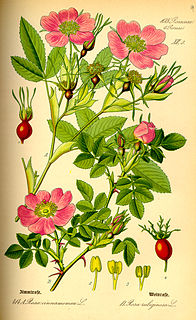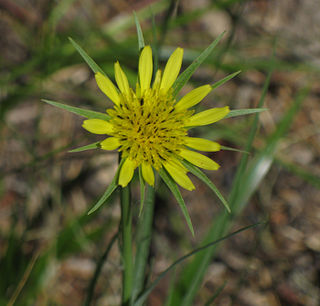
Rosales is an order of flowering plants. It is sister to a clade consisting of Fagales and Cucurbitales. It contains about 7,700 species, distributed into about 260 genera. Rosales comprise nine families, the type family being the rose family, Rosaceae. The largest of these families are Rosaceae (90/2500) and Urticaceae (54/2600). The order Rosales is divided into three clades that have never been assigned a taxonomic rank. The basal clade consists of the family Rosaceae; another clade consists of four families, including Rhamnaceae; and the third clade consists of the four urticalean families.

Tragopogon, also known as goatsbeard or salsify, is a genus of flowering plants in the sunflower family. It includes the vegetable known as salsify, as well as a number of common wild flowers.

Tragopogon porrifolius is a plant cultivated for its ornamental flower and edible root. It also grows wild in many places and is one of the most widely known species of the salsify genus, Tragopogon. It is commonly known as purple or common salsify, oyster plant, vegetable oyster, Jerusalem star, Jack go to bed, goatsbeard or simply salsify.

Allium canadense, the Canada onion, Canadian garlic, wild garlic, meadow garlic and wild onion is a perennial plant native to eastern North America from Texas to Florida to New Brunswick to Montana. The species is also cultivated in other regions as an ornamental and as a garden culinary herb. The plant is also reportedly naturalized in Cuba.

The rosids are members of a large clade of flowering plants, containing about 70,000 species, more than a quarter of all angiosperms.

Tragopogon dubius is a species of salsify native to southern and central Europe and western Asia and found as far north and west as northern France. Although it has been reported from Kashmir and India, recent evidence suggests that specimens from these areas may be a different species. Western salsify has been introduced into North America where it has become widespread, being reported from all the continental United States except for a few in the far south-east, and all provinces of Canada except Newfoundland and the northern territories.

Tolmiea menziesii is a species of flowering plant in the family Saxifragaceae. It is known by the common names youth on age, pick-a-back-plant, piggyback plant, and thousand mothers. It is a perennial plant native to the West Coast of North America, occurring in northern California, Oregon, Washington, British Columbia and southern Alaska. It occurs as a naturalised plant or garden escape in Scotland, parts of Wales, Northern Ireland and northern and western parts of England.

The basal angiosperms are the flowering plants which diverged from the lineage leading to most flowering plants. In particular, the most basal angiosperms were called the ANITA grade which is made up of Amborella, Nymphaeales and Austrobaileyales.
Hartwrightia is a genus of North American flowering plants in the tribe Eupatorieae of the sunflower family. The genus contains a single species, Hartwrightia floridana, native to the US states of Georgia and Florida. The species is sometimes referred to by the common name Florida hartwrightia.

A spermatophyte, also known as phanerogam or phaenogam, is any plant that produces seeds, hence the alternative name seed plant. Spermatophytes are a subset of the embryophytes or land plants.
Alan W. Meerow is an American botanist, born in New York City in 1952. He specializes in the taxonomy of the family Amaryllidaceae and the horticulture of palms and tropical ornamental plants. He also works on the population genetics and molecular systematics of cycads and palms.

Leslie David Gottlieb (1936–2012) was a United States biologist described by the Botanical Society of America as "one of the most influential plant evolutionary biologists over the past several decades". He was employed at the University of California, Davis for 34 years, and published widely. In addition to his primary work in plant genetics, Gottlieb was an advocate for rare and endangered plant conservation.
Cucurbita fraterna, also known as Cucurbita pepo subsp. fraterna, is a mesophyte plant species of the genus Cucurbita. It is native to Tamaulipas and Nuevo León, Mexico. It has not been domesticated. It is the progenitor and nearest relative of the domesticated species Cucurbita pepo and wild C. pepo is still found in the same areas as C. fraterna. It was formally described by Liberty Hyde Bailey in 1943, in Gentes Herbarum.
Tragopogon mirus, the remarkable goatsbeard, is a plant species considered native to certain regions of North America. Intensive studies over the course of many years have demonstrated that it originated as an allopolyploid hybrid between T. dubius and T. porrifolius, both of which are European species naturalized in the US. Tragopogon mirus has become established in the wild, reproducing by its own, thus deserving recognition as a species.

Allium nevii, known by the common name Nevius' onion or Nevius' garlic, is a plant species native to central Washington and north-central Oregon in the United States. It grows in wet meadows and along stream banks at elevations up to 2000 m.
Pamela Soltis is an American botanist. She is a distinguished professor at the University of Florida, curator at the Florida Museum of Natural History, principal investigator of the Laboratory of Molecular Systematics and Evolutionary Genetics at the Florida Museum of Natural History, and founding director of the University of Florida Biodiversity Institute.
Douglas Soltis is a Distinguished Professor in the Laboratory of Molecular Systematics & Evolutionary Genetics, Florida Museum of Natural History and Department of Biology at the University of Florida. His research interests are in plant evolution and phylogeny, an area in which he has published extensively together with his wife Pamela Soltis and together they were the joint awardees of the 2006 Asa Gray Award. They are the principal investigators in the Soltis laboratory, where they both hold the rank of Distinguished Professor and are contributing authors of the Angiosperm Phylogeny Group.
Dicerandra densiflora, the Florida balm, is a species of flowering plant in the mint family known by the common names scrub mint and scrub balm. It is native to North Central Florida, where it occurs along sand hill habitats. It is a member of the annual subclade of Dicerandra.
Dicerandra odoratissima, commonly known as the rose balm, is a species of Dicerandra native to the Southeastern Coastal Plain, with a geographic range that extends from eastern Georgia to southern South Carolina. Kral (1982) originally suggested that this species was so distinct from the remaining members of the genus that it should be placed in a separate section or a distinct genus. Today, D. odoratissima and its close relative D. radfordiana are members of the Lecontea clade.

Tragopogon orientalis, common name Oriental goat's beard, is a hemicryptophyte herbaceous annual plant in the family Asteraceae,











